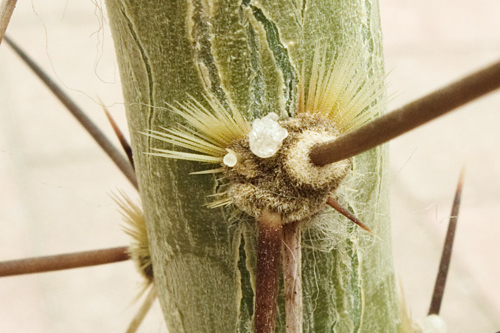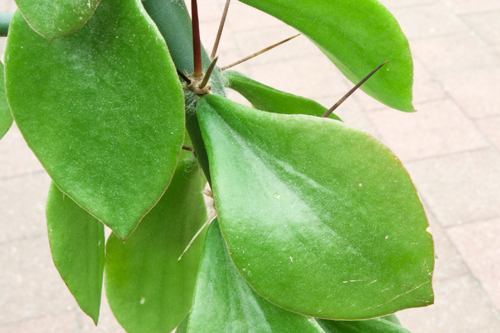In my search for the correct scientific names for the two Pereskiopsis sp. I have at the moment, I came across this interesting document:
http://www.cites.org/eng/cop/14/prop/E14-P25.pdf. In it, there is a sort of determination guide for the different species. But I find it quiet hard to id my species. Especially as I found out that the growing conditions determine the appearance of the plant.
One of the species I have is the kind you see everywere under the name velutina. It grows long and narrow leaves. Has many small spines.
The other (I'll post pictures soon) grows much bigger leaves, has lots of hair in the at areoles, grows few, but large and nasty spines, produces big amounts of small brown glocids in tight bundles that point upwards. It's certainly another species, but which?
Anyone any idea of what species are in fact commonly available? And what is their correct ID?
Pereskiopsis sp.
When it comes to Pereskiopsis and Pereskia, there is precious little information available about them. Fascinating variants on the cactus "theme", they are largely ignored by cactus enthusiasts. This PDF has more info on them than anything else I've seen. Thanks for finding that! Post pics and maybe we can figure it out together.
All Cacti are succulents, but not all succulents are Cacti
Thanks Daiv, it a pleasure to share knowledge here in the forum and to get so much back.
Well, here are some initial picture from the larger species (not the common one used for grafting):
The large (and nasty spines), which I think can grow much larger on older plants:

The areoles. One can see the tight bundles of glochids (beware!). The white cristal is some sort of sugar-like substance produced on older areoles (maybe to attract ants that provide protection?)

The leaves (at least as they look like on plants that have grown in full light, with moderate watering):

The stem with leaves and spines:

The hair that it grows from the areoles, and most obvious on young branches:

But I suppose that getting the plant to flower would be by far the most reliable option to identify the species. Not that I look forward to a large plant with many spines, but I think I'll attempt that to have it produce flowers.
Maybe it would an idea to collect some pictures here on forum from others that have these plants as well?
I think it should be possible to identify the common species with some help from each other.
Well, here are some initial picture from the larger species (not the common one used for grafting):
The large (and nasty spines), which I think can grow much larger on older plants:

The areoles. One can see the tight bundles of glochids (beware!). The white cristal is some sort of sugar-like substance produced on older areoles (maybe to attract ants that provide protection?)

The leaves (at least as they look like on plants that have grown in full light, with moderate watering):

The stem with leaves and spines:

The hair that it grows from the areoles, and most obvious on young branches:

But I suppose that getting the plant to flower would be by far the most reliable option to identify the species. Not that I look forward to a large plant with many spines, but I think I'll attempt that to have it produce flowers.
Maybe it would an idea to collect some pictures here on forum from others that have these plants as well?
I think it should be possible to identify the common species with some help from each other.
Good idea. It would be interesting to know how many people even have one at all. I used to.Maybe it would an idea to collect some pictures here on forum from others that have these plants as well?
I think it should be possible to identify the common species with some help from each other.
On your plant, I might start with an obvious question: How do you know it is a Pereskiopsis and not Pereskia? If you're certain of the genus that narrows down the options considerably.
All Cacti are succulents, but not all succulents are Cacti










